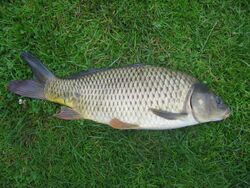Biology:Cyprinus
| Typical carps Temporal range: Miocene–recent
| |
|---|---|

| |
| Wild-type common carp (C. carpio) | |
| Scientific classification | |
| Domain: | Eukaryota |
| Kingdom: | Animalia |
| Phylum: | Chordata |
| Class: | Actinopterygii |
| Order: | Cypriniformes |
| Family: | Cyprinidae |
| Subfamily: | Cyprininae |
| Genus: | Cyprinus Linnaeus, 1758 |
| Type species | |
| Cyprinus carpio | |
| Species | |
|
19 living species | |
| Synonyms | |
| |
Cyprinus /sɪˈpraɪnəs/ is the genus of typical carps in family Cyprinidae. Most species in the genus are of East Asia origin with only the common carp (C. carpio) in Western Asia and Europe; this invasive species has also been introduced to many other regions around the world.[1] Cyprinus are closely related to some more barb-like genera, such as Cyclocheilichthys and Barbonymus (tinfoils). The crucian carps (Carassius) of western Eurasia, which include the goldfish (C. auratus), are apparently not as closely related.[2]
This genus's most widespread and well-known member is the common carp (C. carpio) species complex. Although traditionally considered a single species, recent authorities have split the European and West Asian populations from the East Asian, with the latter named C. rubrofuscus (syn. C. carpio haematopterus).[3][4] Members of the species complex are famed as a food fish and have been widely traded and introduced since antiquity, but in certain areas has multiplied inordinately and become a pest. In its long use it has been domesticated, and a number of breeds have been developed for food and other purposes. The koi (from Japanese nishikigoi, 錦鯉) are well-known carp breeds, selectively bred for being enjoyed by spectators from above. Strictly speaking, koi is simply the Japanese name of the East Asian carp.
The other species of typical carp are generally found in more restricted areas of eastern Asia, centered on the Yunnan region. In some cases, they are endemic to a single lake, most notably Lake Erhai, as well as Lake Dian, Fuxian Lake, Lake Jilu, Lake Qilihu, Lake Xingyun and Lake Yi-Lung, which are all in Yunnan proper. Several of these species are seriously threatened and five are possibly already extinct: C. yilongensis (Lake Yi-Lung), C. yunnanensis (Lake Qilihu), C. daliensis (Lake Erhai), C. megalophthalmus (Lake Erhai) and C. fuxianensis (Fuxian Lake).[5][6][7]
Species
The following species are currently recognized in the genus.[8]
- Cyprinus acutidorsalis H. L. Chen & H. Q. Huang, 1977
- Cyprinus barbatus H. L. Chen & H. Q. Huang, 1977
- Cyprinus carpio Linnaeus, 1758

- Cyprinus chilia H. W. Wu, G. R. Yang, P. Q. Yue & H. J. Huang, 1963
- Cyprinus dai (V. H. Nguyễn & L. H. Doan, 1969)
- Cyprinus daliensis H. L. Chen & H. Q. Huang, 1977
- Cyprinus exophthalmus Đ. Y. Mai, 1978
- Cyprinus fuxianensis Yang et al., 1977
- Cyprinus hieni T. T. Nguyen & A. T. Ho, 2003
- Cyprinus hyperdorsalis V. H. Nguyễn, 1991
- Cyprinus ilishaestomus H. L. Chen & H. Q. Huang, 1977
- Cyprinus intha Annandale, 1918
- Cyprinus longipectoralis H. L. Chen & H. Q. Huang, 1977
- Cyprinus longzhouensis Y. J. Yang & H. Q. Huang, 1977
- Cyprinus megalophthalmus H. W. Wu et al., 1963
- Cyprinus melanes (Đ. Y. Mai, 1978)
- Cyprinus micristius Regan, 1906
- Cyprinus multitaeniatus Pellegrin & Chevey, 1936
- Cyprinus pellegrini T. L. Tchang, 1933
- Cyprinus qionghaiensis C. H. Liu, 1981
- Cyprinus quidatensis T. T. Nguyen, V. T. Le, T. B. Le & X. K. Nguyễn, 1999
- Cyprinus rubrofuscus Lacépède, 1803

- †Cyprinus yilongensis Yang et al., 1977
- Cyprinus yunnanensis T. L. Tchang, 1933
Fossil species
- †Cyprinus priscus von Meyer (fossil species from Miocene Germany)
Footnotes
- ↑ "Cyprinus carpio". ISSG. 4 October 2010. http://www.iucngisd.org/gisd/speciesname/Cyprinus+carpio.
- ↑ de Graaf et al. (2007)
- ↑ Huckstorf, V. (2012). "Cyprinus rubrofuscus". IUCN Red List of Threatened Species 2012: e.T166052A1108337. doi:10.2305/IUCN.UK.2012-1.RLTS.T166052A1108337.en. https://www.iucnredlist.org/species/166052/1108337. Retrieved 12 November 2021.
- ↑ Froese, Rainer and Pauly, Daniel, eds. (2017). "Cyprinus rubrofuscus" in FishBase. February 2017 version.
- ↑ Zhou, W. (2011). "Cyprinus yilongensis". IUCN Red List of Threatened Species 2011: e.T6179A12546193. doi:10.2305/IUCN.UK.2011-2.RLTS.T6179A12546193.en. https://www.iucnredlist.org/species/6179/12546193. Retrieved 12 November 2021.
- ↑ Cui, K. (2011). "Cyprinus yunnanensis". IUCN Red List of Threatened Species 2011: e.T166169A6186294. doi:10.2305/IUCN.UK.2011-2.RLTS.T166169A6186294.en. https://www.iucnredlist.org/species/166169/6186294. Retrieved 12 November 2021.
- ↑ Wang, Wang, Li, Du, Yang, Lassoie, and Hassan (2013). Six decades of changes in vascular hydrophyte and fish species in three plateau lakes in Yunnan, China. Biodivers. Conserv. 22: 3197–3221. doi: 10.1007/s10531-013-0579-0
- ↑ Froese, Rainer and Pauly, Daniel, eds. (2017). Species of Cyprinus in FishBase. February 2017 version.
References
- de Graaf, Martin; Megens, Hendrik-Jan; Samallo, Johannis & Sibbing, Ferdinand A. (2007): Evolutionary origin of Lake Tana's (Ethiopia) small Barbus species: indications of rapid ecological divergence and speciation. Anim. Biol. 57(1): 39–48. doi:10.1163/157075607780002069 (HTML abstract)
Wikidata ☰ Q134653 entry
 |


